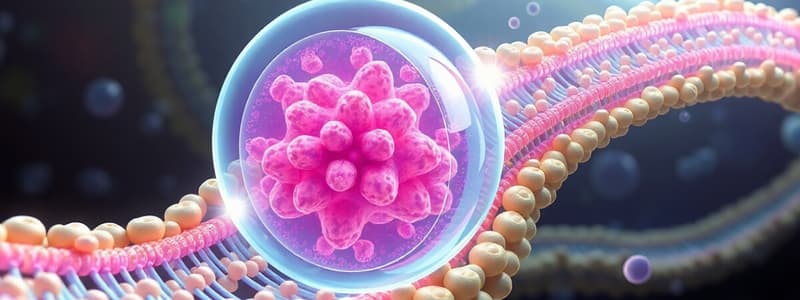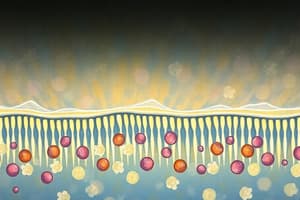Podcast
Questions and Answers
Which of the following characteristics is LEAST associated with passive membrane transport?
Which of the following characteristics is LEAST associated with passive membrane transport?
- Movement of molecules down an electrochemical gradient
- Facilitated by channel or carrier proteins (correct)
- Requirement of cellular energy expenditure
- Involvement of simple diffusion across the lipid bilayer
The lipid-water partition coefficient (R) is a measure of a molecule's:
The lipid-water partition coefficient (R) is a measure of a molecule's:
- Ability to be actively transported across membranes
- Relative solubility in lipids compared to water
- Solubility in aqueous environments only (correct)
- Rate of transport across protein channels
In the context of membrane transport, 'uniport' refers to:
In the context of membrane transport, 'uniport' refers to:
- The coupled transport of two or more different molecules in the same direction.
- A transport mechanism that requires ATP hydrolysis. (correct)
- The simultaneous transport of two different molecules in opposite directions.
- The movement of a single type of molecule across the membrane.
According to Fick's first law of diffusion, the rate of diffusion is NOT directly proportional to:
According to Fick's first law of diffusion, the rate of diffusion is NOT directly proportional to:
During gas exchange in the alveoli of the lungs, oxygen moves from the alveoli into the blood capillaries primarily via:
During gas exchange in the alveoli of the lungs, oxygen moves from the alveoli into the blood capillaries primarily via:
The Henderson-Hasselbalch equation is most relevant for understanding the passive transport of:
The Henderson-Hasselbalch equation is most relevant for understanding the passive transport of:
General anesthetics with a higher lipid-water partition coefficient (R) typically:
General anesthetics with a higher lipid-water partition coefficient (R) typically:
Transdermal drug delivery systems (TDDS) are particularly effective for administering drugs that are:
Transdermal drug delivery systems (TDDS) are particularly effective for administering drugs that are:
Liposomes, used in drug delivery, facilitate drug uptake into cells primarily by:
Liposomes, used in drug delivery, facilitate drug uptake into cells primarily by:
Lysosomotropic amines accumulate in lysosomes because:
Lysosomotropic amines accumulate in lysosomes because:
Local anesthetics like lidocaine primarily exert their effect by:
Local anesthetics like lidocaine primarily exert their effect by:
Compared to bupivacaine, lidocaine may penetrate inflamed tissues more effectively because:
Compared to bupivacaine, lidocaine may penetrate inflamed tissues more effectively because:
Daunorubicin, an anticancer drug, accumulates in lysosomes of tumor cells. This accumulation can:
Daunorubicin, an anticancer drug, accumulates in lysosomes of tumor cells. This accumulation can:
Facilitated diffusion, unlike simple diffusion, exhibits saturation kinetics because:
Facilitated diffusion, unlike simple diffusion, exhibits saturation kinetics because:
GLUT1-5 uniporters are specific for D-glucose but not L-glucose. This specificity is due to:
GLUT1-5 uniporters are specific for D-glucose but not L-glucose. This specificity is due to:
Valinomycin is a carrier-type ionophore antibiotic that facilitates the transport of:
Valinomycin is a carrier-type ionophore antibiotic that facilitates the transport of:
Ion channels are characterized by a very high transport rate primarily because:
Ion channels are characterized by a very high transport rate primarily because:
Voltage-gated ion channels open or close in response to changes in:
Voltage-gated ion channels open or close in response to changes in:
Ligand-gated ion channels require the binding of a specific molecule to:
Ligand-gated ion channels require the binding of a specific molecule to:
Mechanically-gated ion channels are primarily activated by:
Mechanically-gated ion channels are primarily activated by:
'Leak' or 'background' potassium channels are distinct from other types of potassium channels because they are:
'Leak' or 'background' potassium channels are distinct from other types of potassium channels because they are:
Gap junctions facilitate intercellular communication by allowing the passage of:
Gap junctions facilitate intercellular communication by allowing the passage of:
A connexon is a structural subunit of a gap junction channel, composed of:
A connexon is a structural subunit of a gap junction channel, composed of:
Increased intracellular calcium concentration ([Ca2+]i) typically leads to:
Increased intracellular calcium concentration ([Ca2+]i) typically leads to:
Voltage-gating of gap junction channels in cardiac cells suggests that:
Voltage-gating of gap junction channels in cardiac cells suggests that:
Phosphorylation of connexin proteins in gap junctions generally leads to:
Phosphorylation of connexin proteins in gap junctions generally leads to:
Which of the following is NOT a characteristic of facilitated diffusion?
Which of the following is NOT a characteristic of facilitated diffusion?
The permeability constant (P) in the context of membrane diffusion is directly proportional to:
The permeability constant (P) in the context of membrane diffusion is directly proportional to:
Which of the following molecules would likely have the highest permeability coefficient across a lipid bilayer?
Which of the following molecules would likely have the highest permeability coefficient across a lipid bilayer?
In renal tubules, the reabsorption of water in the descending limb of the loop of Henle is primarily driven by:
In renal tubules, the reabsorption of water in the descending limb of the loop of Henle is primarily driven by:
Flashcards
Passive Transport
Passive Transport
Membrane transport that doesn't require energy input.
Ligand-gated Ion Channel
Ligand-gated Ion Channel
A channel protein in the cell membrane that opens or closes in response to a chemical signal.
Mechanically-gated Ion Channel
Mechanically-gated Ion Channel
An ion channel that opens or closes in response to mechanical stimuli.
Always Open Ion Channel
Always Open Ion Channel
Signup and view all the flashcards
Voltage-gated Ion Channel
Voltage-gated Ion Channel
Signup and view all the flashcards
Gap Junction
Gap Junction
Signup and view all the flashcards
Simple Diffusion
Simple Diffusion
Signup and view all the flashcards
Facilitated Diffusion
Facilitated Diffusion
Signup and view all the flashcards
Uniport
Uniport
Signup and view all the flashcards
Symport
Symport
Signup and view all the flashcards
Antiport
Antiport
Signup and view all the flashcards
Lipid-Water Partition Coefficient
Lipid-Water Partition Coefficient
Signup and view all the flashcards
TDDS
TDDS
Signup and view all the flashcards
Liposomes
Liposomes
Signup and view all the flashcards
Passive transport
Passive transport
Signup and view all the flashcards
Henderson-Hasselbalch equation
Henderson-Hasselbalch equation
Signup and view all the flashcards
Daunorubicin
Daunorubicin
Signup and view all the flashcards
Facilitated Diffusion
Facilitated Diffusion
Signup and view all the flashcards
Ion Channels
Ion Channels
Signup and view all the flashcards
Facilitated Diffusion
Facilitated Diffusion
Signup and view all the flashcards
Maximum rate of transport
Maximum rate of transport
Signup and view all the flashcards
Facilitated Diffusion
Facilitated Diffusion
Signup and view all the flashcards
Permeable Material
Permeable Material
Signup and view all the flashcards
Study Notes
- Passive transport through cell membranes reviewed lecture content
- Key topics include classification of membrane transports, passive transport in biological membranes, diffusion, and transport of hydrophobic molecules
- The content explores pH-dependent partitioning, facilitated diffusion, ion channels, and gap junctions, as well as the pharmacological aspects related to anesthetics, TDDS, and liposomes
Classification of Membrane Transport
- Membrane structure dictates whether transport occurs through a lipid bilayer or a more complex biological membrane, and how many layers are involved
- Energetics classifies transport as passive (simple or facilitated diffusion) or active (primary or secondary)
- Transport is also categorized by the number of substances moved (uniport, symport, antiport) and the substance's solubility (hydrophilic, hydrophobic)
Real (Biological) Membranes
- Passive transport occurs along an electrochemical gradient
- Active transport happen against an electrochemical gradient
- Use "Electrochemical gradient" for charged particles because "concentration gradient" is not exact
Simple Passive Diffusion
- Rate of diffusion through a membrane is determined by concentration gradient, charge, membrane potential, and a permeability constant
- R is the lipid-water partition coefficient (hydrophobic vs. hydrophilic)
- D₁ is a constant in lipid membrane
- d is membrane thickness
Fick's Laws of Diffusion
- Fick's 1st Law defines diffusion in general, and also describes charged particles
- Fick's Law describes diffusion through a cell membrane as a relationship to molecule permeability (Px), concentration difference (Δcx), and an electrical potential term
- PX is the permeability of molecule X through the membrane; a ratio of Rx (water–lipid partition coefficient), DL (diffusion coefficient), and d (membrane thickness).
Passive Diffusion Examples in Humans
- Gas exchange in alveoli and reabsorption in renal tubules.
Transport of Hydrophobic Molecules
- Passive transport depends on R, the lipid/water partition coefficient
- Hydrophobic molecules have R > 1
Henderson-Hasselbalch Equation
- The Henderson-Hasselbalch equation determines partition
- It relates pH to pKa and the concentrations of neutral [M] and charged forms [M+]
- The formula is pH = pKa + log([M]/[M+]) or log([M]/[M+]) = pH - pKa
- When pH > pKa, [M] > [M+], meaning a more neutral form exists
- When pH < pKa, [M] < [M+], meaning a more charged form exists
- When pH = pKa, then [M] = [M+]
Lipid-Water Partition Coefficient (R)
- Defines accumulation in the membrane and inside the cell for small, non-charged molecules
- Higher R indicates greater concentration
General Anesthetics
- General anesthetics change the gating of ion channels and/or activate enzymes
- This results in phosphatidic acid generation, which may activate K+ channels and cause hyperpolarization.
- They are lipid soluble, and their efficacy is linked to their R value
- They affect receptors (e.g., GABA, glutamate receptor) and ion channels (e.g., K+ leak) in the cell membrane
- Specific examples across groups include intravenous and inhalational anesthetics, with diverse effects on chloride channels, NMDA receptors, and various ion channels
TDDS (Transdermal Drug Delivery System)
- TDDS involves transdermal exposure via ointments, creams, or patches
- Skin is permeable to hydrophobic molecules
- TDDS uses a large surface area and good blood/lymphatic supply
- The stratum corneum is the key barrier at ~10 µm of dead, keratin-filled cells
- Drugs with a high lipid-water partition coefficient are delivered via comfortable, controlled patches
- The significant transport of drugs with high lipid-water partition coefficient (R), can be increased by preventing the evaporation
Liposomes in medicine
- Liposomes work through fusion with the cell membrane for non-specific uptake in cancer therapy and vaccination
pH Dependent Partitioning
- Uses the Henderson-Hasselbalch equation to determine intracellular distribution of amphiphilic molecules
"Lysosomotropic Amines"
- "Lysosomotropic amines" accumulate in lysosomes
- They passively diffuse across lipid bilayers and become ionized in lysosomes
- This accumulation can be harmful and affect drug efficacy
- Examples are lidocaine, and cytostatic drugs
Local Anesthetics: pH, pKa
- Local anesthetics include bupivacaine, lidocaine, mepivacaine, procaine, ropivacaine, tetracaine
- They block sodium channels from the intracellular side, suppressing neuronal excitability
- Acidic extracellular spaces enhance lidocaine penetration, whereas bupivacaine protonates more
Daunorubicin
- Daunorubicin: a DNA-intercalating drug for cancer treatment that is an amine that can be protonated
- Daunorubicin accumulates in lysosomes
- This reduces its nuclear effects in tumor cells
Facilitated Diffusion
- This is the movement of a molecule across the cellular membrane using trans-membrane protein
- Occurs without energy expenditure, along the electrochemical gradient
- Transporter is needed that specifically binds the molecule to be transported
- i.e. GLUT1-5 uniporters binds D- glucose
- Not L isomeric variant, or ion channels are selective for certain type of ions)-
- The rate is limited by the number of transporting molecules
- It can be inhibited by specific antagonists, i.e. TTX for Nav channels
Glucose Transporters (GLUTs)
- Mediates glucose uniport into cells
Ion Channels
- Ion channels selectively allows facilitated diffusion
- selective pores for the given type(s) of ions
- This follows the electrochemical gradient
- Ion channels have a very high transport rate
- Effective at regulation of the intercellular ion concentration relative to membrane potential
- Controlled gated opening
- This is a switch in the signaling process, remember AP generation
Ion Channel Types include
- Voltage-gated, Ligand-gated, IC signal-gated and Stretch/mechanically-gated
- G-protein (7-TM receptor) gated
- Leak/background channels (always open)
Gap Junctions
- Gap Junctions transport molecules between cells -diffusion of molecules across cell membranes (fluorescent dye)
- Permeable to small molecules, both polar and non-polar
- For example, ATP, ADP, cAMP, IP3, Ca2+, glutamate, glutathione, Na+, K+, Cl-
- They are facilitated by connexion in the plasma membrane
Regulation of Gap Junction Channels:
- Dopamine increases Calcium presence which closes Gap Junction Channels
- High Hydrogen presence closes Gap Junction Channels
- Voltage Gating of cardiac cannels reduces conductivity
- Connexins or connexons are affected
Keywords:
- Apolar/nonpolar
- Polar
- Facilitated diffusion
- Passive Transport
- Glucose Uniport
- Ion Channel gating
- Ion Channel selectivity
- Gap Junction
- Voltage sensor
Studying That Suits You
Use AI to generate personalized quizzes and flashcards to suit your learning preferences.
Related Documents
Description
Covers passive transport through cell membranes, including diffusion and transport of hydrophobic molecules. Explores pH-dependent partitioning, facilitated diffusion, ion channels, and gap junctions. Also discusses pharmacological aspects like anesthetics and liposomes.



